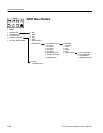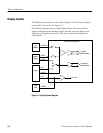
Theory of Operation
3-6
2715 Spectrum Analyzer Service Manual
This is a precision, temperature controlled, quartz crystal oscillator that provides
the reference around which all instrument frequency related performance
revolves. It is designed for maximal frequency stability over temperature and
time, with absolute frequency accuracy being secondary. The instrument
firmware accounts for any frequency inaccuracy, producing a virtually perfect
reference.
The phase gate is a high speed sampling switch that takes a very brief sample of
the 1st LO waveform once during each cycle of the strobe frequency. (The strobe
is a control signal supplied to the phase gate from an external source.) These
samples are later averaged by a low pass filter to eliminate ripple at the strobe
frequency, and also to eliminate other undesirable components.
When the 1st LO is phase locked to any integer multiple of the strobe frequency,
the resulting output is a phase dependent DC voltage that is used as the error
voltage in a feedback loop to maintain phase lock.
When the 1st LO is not phase locked, the resulting output is a beat note
occurring at the difference frequency between the 1st LO frequency and the
nearest integer multiple of the strobe frequency. (Actually, many beat frequencies
are present at once, but the low pass filter eliminates all but the one of lowest
frequency.)
This element is the focal point of the frequency control system hardware. It
accepts commands from the instrument microprocessor and then puts out
appropriate drive signals to the 1st LO as well as a suitable strobe signal to the
Phase Gate. The PLCFC module also uses the Phase Gate output. It also
provides counter signals and status information to the microprocessor. It requires
the 100 MHz reference signal in order to function.
Because of the variety of tasks that the Spectrum Analyzer is called upon to do,
it is essential to have an intelligent controller. This is especially true in the
frequency control context, because the required degree of control could not be
economically obtained with unassisted analog hardware.
Instrument firmware has the task (among many others) of commanding the
frequency control hardware, taking feedback from it, and making readjustments
as required to obtain the desired result.
The interface between the microprocessor system and the PLCF C module is
through a pair of serial data lines, some latch lines, and some clock signals.
100 MHz Reference
Oscillator
Phase Gate
Phase Lock Center
Frequency Control
(PLCFC)
Firmware


















